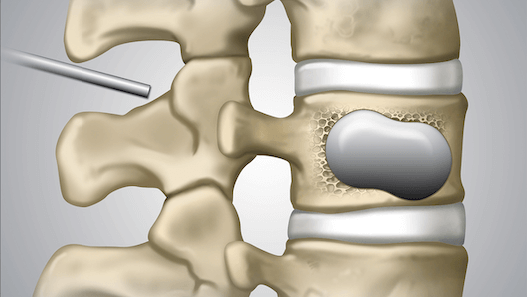Fixing a Fracture: How Kyphoplasty is Reshaping Spinal Care
&srotate=0)
What is Kyphoplasty?
Kyphoplasty is a minimally invasive surgery designed to treat spinal compression fractures, which commonly result from osteoporosis or cancer-related bone deterioration.
The Procedure: Step-by-Step Process of Kyphoplasty
This technique involves the careful insertion of a bone tamp into a fractured vertebral body, which is then inflated like a balloon. This opens a space in the vertebra so it may then be filled with biocompatible bone cement. The primary objective of this procedure is to stabilize the fracture, restore vertebral body height, and alleviate any associated pain.
The actual procedure requires precision, proper timing, and live X-ray guidance for most of its duration. First, a small incision is made in the patient's back so a trocar may be guided into the fractured vertebra. A balloon is then threaded through the trocar and carefully inflated with contrast dye (so it is visible on X-ray. This expansion serves to create a cavity and restore the height of the compressed vertebra. Once the desired shape and size have been achieved, the balloon is deflated and removed. Immediately after, polymethylmethacrylate (PMMA) is injected into the newly created space. The biocompatible material quickly hardens from a paste into the bone cement, thereby stabilizing the fracture and the vertebral body’s restored height.
Recovery: After the Procedure and Follow-ups
The typical kyphoplasty procedure lasts between one to two hours and can be performed under local anesthesia or conscious sedation (depending on the patient's overall health and the doctor's discretion). Most patients report immediate pain relief and the ability to return to their daily activities after a few days. Regular follow-ups are necessary so the provider can monitor for potential complications and ensure sustained relief has been achieved.
Benefits: Advantages of Kyphoplasty
Kyphoplasty offers numerous benefits, with the most notable being rapid and prolonged reductions in pain levels among most individuals (72%) who undergo the procedure. In fact, the relief following treatment often lasts for up to 3 years. Additionally, it contributes to improved long-term spinal alignment by correcting the spinal deformity caused by the vertebral fracture. Being that kyphoplasty is an outpatient procedure, it is associated with smaller incisions, less blood loss, and reduced risk of complications when compared to traditional, open surgeries.
Considerations: Potential Drawbacks and Limitations
Despite the numerous advantages, there are potential drawbacks to kyphoplasty that patients should also consider. Associated risks of the procedure include infection, cement leakage into surrounding areas, and development of fractures in adjacent vertebrae. The procedure is limited in the types of fractures it can treat, and the timing of intervention can be a critical factor for successful outcomes. Nevertheless, when performed by trained providers and their assisting surgical teams, kyphoplasty has the potential to offer significant relief to patients dealing with spinal compression fractures.
If you are struggling with spinal compression fractures, consider booking a consultation with Ospina Medical to determine if kyphoplasty is the right procedure for you.
Author: Camden Rowe
Medically Reviewed By: Matthew Kohler, MD